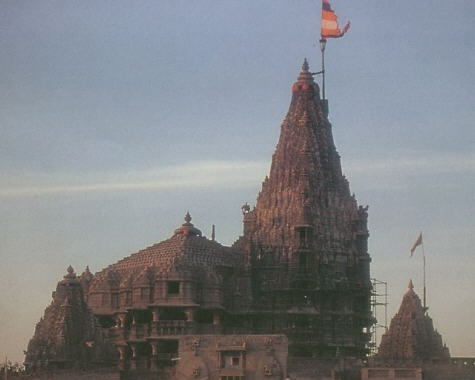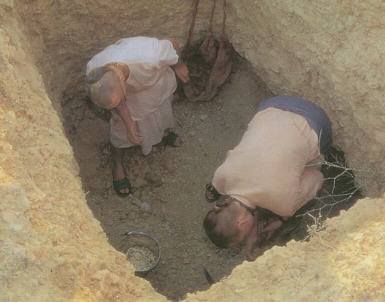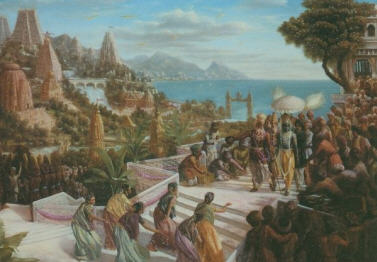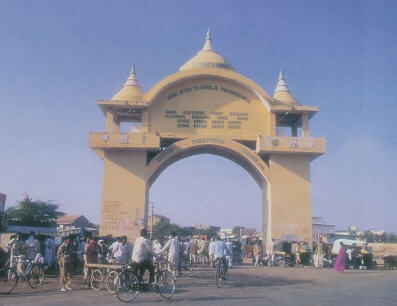The city's original opulence may no longer be visible,
but one can still gain inspiration from the piety of its people.
DVARAKA is the sacred city where Lord Krsna, the Supreme Personality of Godhead, spent most of His time during His appearance on earth five thousand years ago. He performed wonderful pastimes there, including expanding into 16,108 forms and creating 16,108 palaces for His 16,108 queens. In Vrndavana, Lord Krsna lived as a simple cowherd boy, but in Dvaraka He lived as a wealthy prince.

Lord Dvarkadhisa Temple
Dvaraka means "gateway to the Supreme" or "city of gates." Traditionally, an opulent city would have many gates, indicating the king's confidence in protecting the city. In present-day Dvaraka there were no gates until ISKCON, to commemorate its Padayatra (walking pilgrimage throughout India) and Srila Prabhupada's Centennial, established the Srila Prabhupada Gate at the entrance to the city in 1988.
The original city of Dvaraka, described in the Srimad-Bhagavatam, the Mahabharata, and other Vedic scriptures, was a fort city built within the sea. Lord Krsna built Dvaraka to protect His kinsmen, the Yadu dynasty, from repeated attacks by kings and armies intent on killing Him. By the will of the Lord, Dvaraka disappeared into the sea at the time of the Lord's departure from this world. Archaeological excavations have brought out from the sea many artifacts suggesting that an opulent city stood there in the distant past.
The present city Dvaraka ("Dwarka" on the map) is on the shore. It has a resident population of approximately 30,000, and a tourist population that fluctuates with the seasons. Even though it's remote on the west coast and a long way from any major cities many pilgrims make the endeavor to go there. When I arrived with a group of traveling book distributors one cool January morning, we saw buses from as far away as West Bengal and Tamil Nadu, both on the east coast. Dvaraka is one of the most important places for Hindus to visit because it is one of the four prominent holy places in the cardinal directions of India: Dva-raka (west), Puri (east), Rameswaram (south), and Badrinath (north).
Of the visitors to Dvaraka from within Gujarat, city dwellers tend to visit on weekends, when they're free from work, whereas villagers go at any time, according to their farming schedule. Villagers traditionally walk to Dvaraka in groups, bringing beautiful ornate, brightly-colored flags of various designs. The groups present the flags to the temple and then perform the pious act of feeding a group of brahmanas. When pilgrims see their flags flown above the temple, they feel great satisfaction. (To change the flags, a temple worker must climb to the top of the temple spire. It's a long way up 235 feet and there's usually a strong wind, but the workers don't seem to mind.)
The atmosphere in Dvaraka is peaceful. The people are pious and don't seem harassed by many problems. They happily go to the temple to see the Lord. We arrived in Dvaraka at 6:30 in the morning, and although it was still dark, quite a few people were walking toward the main temple, that of Dvarakadhisa, "the Lord of Dvaraka," a four-armed Deity of Krsna. By the blessings of Lord Krsna, the opulence of Dvaraka survives. Although we don't see fabulously rich people, the ordinary people live a comfortable life.
Regal Worship
Because Lord Krsna lived in Dvaraka as a prince, He is worshiped there in that mood. The Dvarakadhisa Deity is opulently dressed, and the symbols in His four hands (conch, club, disc, and lotus) are covered in silver. During the worship, brahmanas colorfully dressed with solid red or yellow dhotis and with shirts made from flags that have flown over the temple beat drums and blow conch shells.
Within the compound of the Dvarakadhisa temple, built in the sixteenth century, are many small shrines, including those of Laksmi, Siva, Radhika, Balarama, Pradyumna, Aniruddha, Jambavati, Satyabhama, and Purusottama Visnu.
Directly facing Dvarakadhisa is the shrine of Devaki, Krsna's mother. She's looking at Krsna, and He's looking at her. In the Devaki shrine after the mangala-arati (the early-morning worship), brahmana boys sit in brightly colored clothes and chant Vedic scriptures, creating a soothing and auspicious atmosphere.
One day while we performed kirtana in the Dvarakadhisa temple, the priest serving the Deity showed his appreciation by smiling, raising his arms, and swaying to the sound of Krsna's names.
Religious Gatherings
Dvaraka is a pleasant town on the coast, with a nice strip of beach. The sea is calm there. The climate is moderate, not too hot in summer or too cold in winter. Because the summer there is not as hot as in many other parts of India, religious speakers go there during that time, and many, many people congregate to hear them. Dvaraka is considered an important place to hold such functions.
Other Noteworthy Temples
The temple of Samudra Narayana sits where the Gomati River, one of the important holy rivers of India, reaches the sea in the town of Dvaraka. Samudra Narayana is Krsna's expansion as Lord Narayana lying on the Garbhodaka Ocean. This old temple is the only temple of Samudra Narayana anywhere.
On the bank of the river near the estuary is an ashram where sadhus live. Some have been there for more than thirty years. Some cook for themselves, and some go to the annaksetra, where food is given for free. They live simply and perform various kinds of spiritual practices. Their lives are not meant for materialistic sense gratification.
The river forks just before reaching the sea, producing a small island on which sits a temple of Laksmi Narayana. The site is ancient, although the present temple is not very old.
On a side road, we found a temple where the chanting of "Sri Rama, Jaya Rama, Jaya Jaya Rama" has been going on nonstop for the last twenty-eight years. The two people chanting invited us to join in. They were very enthusiastic in their chanting. We were there during the daytime, when few people come. In the evening more people arrive, and on festival days huge crowds gather there to chant the names of Lord Rama.
One place worth visiting is the lighthouse (open only from 4:30 to 6:00 in the evening). From the top you get a wonderful view of the sea, the town of Dvaraka, and the dry plains beyond the town.
Bet Dvaraka
Thirty kilometers up the road from Dvaraka is a village named Okha, which most people go to simply to take the pleasant twenty-minute boat ride to Bet Dvaraka. Bet is the Gujarati word for "island." On this island sits an old Dvarakadhisa temple. People here are proud of Bet Dvaraka, even claiming that it is the "real Dvaraka."

About halfway to Bet Dvaraka and five kilometers off the main road is Gopi Tallav, the pond where Krsna met with the gopis, His cowherd girlfriends from Vrndavana. This sacred spot is the source of gopi-candana, a clay that Krsna's devotees use to decorate their foreheads. Everyone is allowed to take freely, so we all stocked up on enough for the next few years.
About three kilometers outside Dvaraka, on the road to Bet Dvaraka, is the temple of Rukmini, Krsna's chief queen. The architecture of the temple is beautiful, and the walls are decorated with paintings of the pastimes of Rukmini and Krsna. The temple is said to have been built in the twelfth century.
Dvaraka is a good place to visit for several days to get away from the rush and frustrations of city life. Pilgrims can go there to relax and consider the ultimate goal of life.
Srila Prabhupada writes: "The heavenly planets are more celebrated than the earth. But the celebrity of earth has defeated that of the heavenly planets because of Dvaraka, where Lord Sri Krsna reigned as king. Three places, namely Vrndavana, Mathura, and Dvaraka, are more important than the famous planets within the universe. These places are perpetually sanctified because whenever the Lord descends on earth He displays His transcendental activities particularly in these three places. They are perpetually the holy lands of the Lord, and the inhabitants still take advantage of the holy places, even though the Lord is now out of their sight." (Srimad-Bhagavatam 1.10.27, Purport)
When we left Dvaraka, we stopped to take photos from the road. We looked out over the plain from which the small town seems to rise suddenly across the banks of the Gomati. Dvaraka's many temple spires point up to indicate that our goal is not here but upwards. We could see the Dvarakadhisa temple dominating the skyline, and the lighthouse standing prominently in the distance behind it.
During the few minutes we stopped to take photos, several pilgrimage buses came rushing by. The cycle of life in Dvaraka today is as it has been for hundreds of years. As new pilgrims come, others leave. Previously, most pilgrims came by foot, and the richer ones would ride horses or be carried on palanquins. Nowadays, people mostly come by bus or train, but still the cycle goes on and on and on.
This was our good-bye to Dvaraka. We don't know when we'll be back, but we certainly hope to return. And we wish to return to Dvaraka of the spiritual world. In His mercy, Lord Krsna has left us a replica Dvaraka to point us back to our eternal destination.
Bhakti Vikasa Swami hails from England but has lived in India for many years. He teaches Krsna consciousness at the ISKCON center in Baroda, Gujarat.
Dvaraka Fifty Centuries Ago
The following description of Dvaraka during Krsna's presence there appears in the Srimad-Bhagavatam (10.69.1-12) in connection with the sage Narada's visit.

The City Was Filled with the sounds of birds and bees flying about the parks and pleasure gardens, while its lakes, crowded with blooming indivara, ambhoja, kahlara, kumuda, and utpala lotuses, resounded with the calls of swans and cranes.
Dvaraka boasted 900,000 royal palaces, all constructed with crystal and silver and splendorously decorated with huge emeralds. Inside these palaces, the furnishings were bedecked with gold and jewels.
Traffic moved along a well laid-out system of boulevards, roads, intersections, and marketplaces, and many assembly houses and temples of demigods graced the charming city. The roads, courtyards, commercial streets, and residential patios were all sprinkled with water and shaded from the sun's heat by banners waving from flagpoles.
In the city of Dvaraka was a beautiful private quarter worshiped by the planetary rulers. This district, where the demigod Visvakarma had shown all his divine skill, was the residential area of Lord Hari [Krsna], and thus it was gorgeously decorated by the sixteen thousand palaces of Lord Krsna's queens. Narada Muni entered one of these immense palaces.
Supporting the palace were coral pillars decoratively inlaid with vaidurya gems. Sapphires bedecked the walls, and the floors glowed with perpetual brilliance. In that palace Tvasta had arranged canopies with hanging strands of pearls; there were also seats and beds fashioned of ivory and precious jewels. In attendance were many well-dressed maidservants bearing lockets on their necks, and also armor-clad guards with turbans, fine uniforms, and jeweled earrings.
The glow of numerous jewel-studded lamps dispelled all darkness in the palace. My dear king, on the ornate ridges of the roof danced loudly crying peacocks, who saw the fragrant aguru incense escaping through the holes of the latticed windows and mistook it for a cloud.
ISKCON Dvaraka

ISKCON OPENED a temple in Dvaraka in 1996 in a house donated by Pritish Bharatia, a friend of Yasomatinandana Dasa, president of ISKCON Ahmedabad. The ten-room building sits in a market area that's a three-minute walk from the Dvarakadhisa temple. The Deities of Sri Sri Radha-Syamasundara are in one room; guests, staff, and supplies fill the rest. His Holiness Mahavisnu Goswami oversees the project.
With help from many well-wishers, especially Radha Jivana Dasa from the United States, devotees will begin building a temple on the site in the fall of 1999. The three-story stone temple will feature a temple room and a meeting hall above a dining hall and an ashram.
Isvarabhai Pujari, one of the priests for the Dvarakadhisa temple, is designing the new ISKCON temple. Isvarabhai, an architect, is known for his colorful and devotional dressing of the Dvarakadhisa Deities. His plans for the temple call for outdoor dioramas depicting Lord Krsna's pastimes from Srimad-Bhagavatam. Expert sculptors from Rajasthan will embellish the outside of the temple with traditional stone carvings.
Besides the main temple, the ISKCON Dvaraka project includes a six-acre goshalla (farm for protecting cows) about ten kilometers from town. Lila Avatara Dasa from London has also donated a one-acre plot in the city for future expansion.
When asked about life in Dvaraka, temple resident Vaisnava Seva Dasa said, "Living in one of the four major holy places definitely increases my Krsna consciousness. Materially, living in Dvaraka has been a little austere because of the drought. There have been only seven or eight days of rain over the past year. Water is scarce, but by Krsna's arrangement our temple is one of the few buildings in the city with its own working well."
As his name implies, Vaisnava Seva Dasa ("servant of service to devotees") looks forward to hosting many pilgrims and visitors in the new temple. ISKCON Dvaraka will hold its annual Rathayatra on January 26.
Visiting Dvaraka
How to Get There
Dvaraka is well connected to Mumbai and Ahmedabad by road and rail. The nearest airport is in Jamnagar, about three hours from Dvaraka by train, bus, or taxi.
Getting Around
There are no rickshas in Dvaraka because there's no need. It's a small place. You can get around by walking, or you can rent a bicycle.
Where to Eat
The Dvarakadhisa temple has a system of free prasadam distribution for a limited number of people. Coupons are distributed after mangala-arati (seven o'clock) for lunch, and at midday for the evening meal. Hotel Mera and Hotel Radhika are two of several restaurants that sell inexpensive all-you-can-eat vegetarian meals.
Where to Stay
Don't expect to find luxury accommodations, but here are some clean, comfortable hotels: Toran Tourist Bungalow (phone: 02892-313), Hotel Meera (02892-331), Uttam Guest House (02892-234), Hotel Radhika (02892-754), Hotel Guruprerana (02892-385), and Hotel Gokul (02892-554).
For more travel information, see Holy Places and Temples of India, by Jada Bharata Dasa, available from the Hare Krsna Bazaar http://www.krishna.com.
Calendar
This calendar is calculated for Mayapur, West Bengal, India. The dates, derived from a lunar calendar, may vary by one day for other locations. Consult your local Hare Krsna temple for the exact dates for your area.
Month of Narayana
(December 23-January 21)
January
2 Saphala Ekadasi. Fasting from grains and beans.
7 Appearance anniversary of Srila Locana Dasa Thakura, a great devotee of Krsna known for his Bengali devotional songs.
9 Disappearance anniversary of Srila Jiva Gosvami, one of the six Gosvamis of Vrndavana.
17 Putrada Ekadasi. Fasting from grains and beans.
Month of Madhava
(January 22-February 19)
25 Appearance anniversary of Srila Gopala Bhatta Gosvami, one of the six Gosvamis of Vrndavana.
26 Disappearance anniversary of Srila Jayadeva Gosvami, a great spiritual master and author of Gita-govinda.
27 Disappearance anniversary of Srila Locana Dasa Thakura, a great spiritual master whose Bengali devotional songs perpetuate the simple Krsna conscious method of self-realization.
February
1 Sat-tila Ekadasi. Fasting from grains and beans.
10 Appearance anniversary of Srila Raghunatha Dasa Gosvami, one of the six Gosvamis of Vrndavana. Disappearance anniversary of Srila Visvanatha Cakravarti Thakura, a Vaisnava spiritual master and author who appeared in the seventeenth century. Appearance anniversary of Srimati Visnupriya Devi, the consort of Lord Caitanya.
12 Appearance anniversary of Sri Advaita Acarya, an incarnation of Krsna's expansion Maha-Visnu and a close associate of Lord Caitanya. Fasting till noon.
14 Disappearance anniversary of Sripada Madhvacarya, a Vaisnava philosopher and spiritual master who appeared in the thirteenth century.
15 Disappearance anniversary of Srila Ramanujacarya, an eleventh-century philosopher and spiritual master.
16 Trisprsa Mahadvadasi. Fasting from grains and beans for Bhaimi Ekadasi. Appearance anniversary of Lord Varaha, Lord Krsna's boar incarnation. Fasting till noon, feasting tomorrow.
17 Appearance anniversary of Lord Nityananda Prabhu, a close associate of Lord Caitanya Mahaprabhu and an incarnation of Lord Krsna's elder brother, Lord Balarama. Fasting till noon yesterday, feasting today.
19 Appearance anniversary of Srila Narottama Dasa Thakura, a spiritual master in the disciplic line from Lord Caitanya who composed many devotional songs in Bengali.
Month of Govinda
(February 20-March 20)
24 Appearance anniversary of Srila Bhaktisiddhanta Sarasvati Thakura, spiritual master of Srila A.C. Bhaktivedanta Swami Prabhupada, the Founder-Acarya of the International Society for Krishna Consciousness. Fasting till noon, then feasting. Disappearance anniversary of Sripada Gour Govinda Swami, an ISKCON guru.
